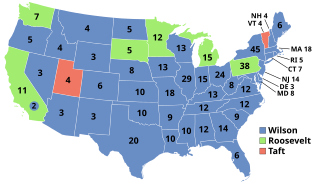
The United States presidential election of 1912 was the 32nd quadrennial presidential election, held on Tuesday, November 5, 1912. Democratic Governor Woodrow Wilson of New Jersey unseated incumbent Republican President William Howard Taft and defeated former President Theodore Roosevelt, who ran as the Progressive Party nominee. Roosevelt remains the only third party presidential candidate in U.S. history to finish better than third in the popular or electoral vote.

The United States presidential election of 1916 was the 33rd quadrennial presidential election, held on Tuesday, November 7, 1916. Incumbent Democratic President Woodrow Wilson defeated Supreme Court Justice Charles Evans Hughes, the Republican candidate. Wilson was the only sitting Democratic president to win re-election between 1832 and 1936.

The United States presidential election of 1924 was the 35th quadrennial presidential election, held on Tuesday, November 4, 1924. In a three-way contest, incumbent Republican President Calvin Coolidge won election to a full term.

Hiram Warren Johnson was initially a leading American progressive and then a Liberal Isolationist Republican politician from California. He served as the 23rd Governor of California from 1911 to 1917 and as a United States Senator from 1917 to 1945. He was also Theodore Roosevelt's running mate in the 1912 presidential election on the Progressive ticket.
Edward E. Clark is an American lawyer and politician who ran for Governor of California in 1978, and for President of the United States as the nominee of the Libertarian Party in the 1980 presidential election.

Friend William Richardson was an American newspaper publisher and politician. A member of the Progressive Party and later the Republican Party, Richardson was elected as the California State Treasurer from 1915 to 1923, and shortly afterwards as the 25th governor of California from 1923 to 1927. Richardson's governorship marked a sharp reversal in policies from previous administrations, rolling back many of the Progressive reforms and state governmental agencies put in place by previous governors Hiram Johnson and William Stephens.

Elections to the United States House of Representatives in 1912 were held for members of the 63rd Congress, coinciding with the election of President Woodrow Wilson.
The Progressive Party of 1924 was a new party created as a vehicle for Robert M. La Follette, Sr. to run for president in the 1924 election. It did not run candidates for other offices, and it disappeared after the election. The party advocated progressive positions such as government ownership of railroads and electric utilities, cheap credit for farmers, the outlawing of child labor, stronger laws to help labor unions, more protection of civil liberties, an end to American imperialism in Latin America, and a referendum before any president could lead the nation into war.

The National Union Party was the temporary name used by the Republican Party for the national ticket in the 1864 presidential election which was held during the Civil War. For the most part, state Republican parties did not change their name. The temporary name was used to attract War Democrats and border states, Unconditional Unionists and Unionist Party members who would not vote for the Republican Party. The party nominated incumbent President Abraham Lincoln and for Vice President Democrat Andrew Johnson, who were elected in an electoral landslide.
California is largely a Democratic stronghold and one of the three largest Democratic states in presidential elections alongside New York and Illinois.

The 1914 New York state election was held on November 3, 1914, to elect the Governor, the Lieutenant Governor, the Secretary of State, the State Comptroller, the Attorney General, the State Treasurer, the State Engineer, a U.S. Senator and a judge of the New York Court of Appeals, as well as all members of the New York State Assembly and the New York State Senate, and delegates-at-large to the New York State Constitutional Convention of 1915.

The 1924 United States presidential election in California refers to how California participated in the 1924 United States presidential election. California voters chose thirteen electors, or representatives to the Electoral College, who voted for president and vice president.

The 2016 United States elections were held on Tuesday, November 8, 2016. During this presidential election year, the President of the United States and Vice President were elected. In addition, elections were held for all 435 voting-member seats in the United States House of Representatives and 34 of the 100 seats in the United States Senate to determine the 115th Congress.

The 1924 United States presidential election in New York took place on November 4, 1924. All contemporary 48 states were part of the 1924 United States presidential election. New York voters chose 45 electors to the Electoral College, which selected the president and vice president.

The 1912 United States presidential election in New York took place on November 5, 1912. All contemporary 48 states were part of the 1912 United States presidential election. New York voters chose 45 electors to the Electoral College, which selected the president and vice president.

The 1912 United States presidential election in Massachusetts took place on November 5, 1912, as part of the 1912 United States presidential election, which was held throughout all contemporary 48 states. Voters chose eighteen representatives, or electors to the Electoral College, who voted for president and vice president.

The 1912 United States presidential election in New Jersey took place on November 5, 1912. All contemporary 48 states were part of the 1912 United States presidential election. New Jersey voters chose 14 electors to the Electoral College, which selected the president and vice president.

The 1912 United States elections elected the members of the 63rd United States Congress, occurring during the Fourth Party System. Amidst a division between incumbent Republican President William Howard Taft and former Republican President Theodore Roosevelt, the Democratic Party won the Presidency and both chambers of Congress, the first time they accomplished that feat since the 1892 election.
The California Progressive Party, also named California Bull Moose, was a third party that flourished from 1912 to 1944 and lasted through the 1960s.
















